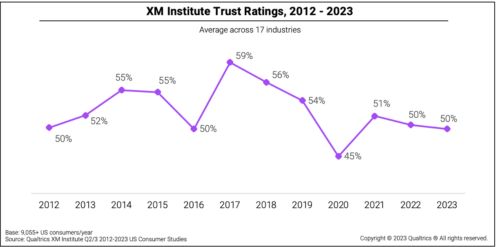
The frontline is where you connect EX and CX together in a very natural way – Interview with Joe Tyrrell of Medallia
February 12, 2024
Leadership lessons from the winner of the 2023 CX Leader of the Year – Interview with Roxie Strohmenger of UKG
February 20, 2024How to gain and keep a customer’s trust has become an ever-present challenge in recent years, with customers becoming increasingly concerned about data, privacy and security issues.
This trust challenge has been exacerbated over the last year with the emergence of Generative AI.
Recent research by Qualtrics XM Institute reveals how big this challenge has become.
For the past 12 years, the XM Institute has surveyed 10,000 US consumers to better understand the level of trust customers have in companies they engage with to take care of their needs.
Their most recent research finds that trust levels between consumers and companies in the US have fallen to their lowest level since 2016 and are also now on par with trust levels from back in 2012.

XM Institute Trust Ratings, 2012-2023 Credit: Qualtrics XM Institute
Here are some of the things that stood out for me from the research:
- The grocery sector came out on top with a trust rating of 59%, followed by investment firms, banks, auto dealers, retailers, consumer payment providers, parcel delivery services, and health insurers, who all earned trust ratings of over 50%.
- Meanwhile, at the other end of the scale, TV and internet service providers were considered the least trustworthy and were the only industry to earn a trust rating lower than 40%.
- Interestingly, the research finds that trust levels tend to increase with age. For instance, the average trust rating across industries was 28% for the 18- to 24-year-old age group, rising to 57% for consumers who are 65 years and older.
I think these are fascinating findings.
But, are they surprising, particularly when you consider that according to Forrester’s US 2023 Customer Experience Index, CX Quality among brands in the US fell for the second year in a row last year?
Perhaps not.
What is clear, however, is that regardless of the sector, there is work to be done if companies are to build both trusted relations with their customers and, at the same time, deliver better outcomes for them.
But what should they be prioritizing? And, what sort of organizational behaviours undermine or bolster trust?
Bruce Temkin, the Head of Qualtrics XM Institute and one of the authors of the recent research, says,
“Just about every interaction with an organization can impact the trust of a customer, employee, or other stakeholders. To avoid losing trust, organizations must display consistency in their actions, avoid overstating their capabilities, take responsibility proactively for any issues, and demonstrate a strong commitment to resolving problems.”
He goes on to say,
“Businesses have one shot at making a positive, strong first impression, and we’ve found that those early interactions set the trajectory for long-term trust. Customers hate surprises – communicate the potential outcomes of a given business interaction and provide very clear signposting throughout the customer journey about the next steps for reaching upcoming service or product milestones.”
But what about the impact of Generative AI on all of this?
Research shows that customers are both interested and excited by the new technology and the possibilities that it presents but are also wary of its use. Matthias Goehler, EMEA CTO at Zendesk, agrees and says,
“Trust is the ultimate currency of the future. At present, we’re hearing a lot of talk in the media about the power of AI, as well as the potential risks. Customers are becoming more wary of the dangers around AI, and it’s the responsibility of the businesses to reassure them that their data is safe. Businesses will have no alternative but to be clear and transparent with customers in order to gain and keep their trust.”
So, to succeed in building trust with their customers, companies need to always have a customer’s best interests at heart, they need to be consistent and proactive, they need to take responsibility for problems that arise and be committed to their resolution, and, finally, they need to be clear and transparent in their communication, particularly when it comes to the use of both their data and new technology.
Simple, right?
Not so fast.
The problem is that this is very similar to the advice and recommendations that I included in a piece that I wrote on a similar topic just under a year ago.
I wrote then that I was alarmed at the state of engagement and suggested that many brands are either not paying attention to their customer’s concerns or they are not acting fast enough on these issues.
I went on to say that customer patience won’t last forever and the companies that are the first to make strides towards building trust with their customers are the ones most likely to win.
That advice was true last year and is set to become even more true this year.
This post was originally published on Forbes.com.
Credit: Photo by Ronda Dorsey on Unsplash




